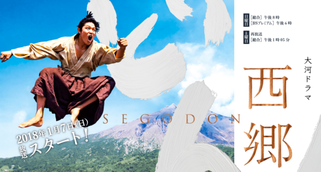 Source: www.dorama9.com
Source: www.dorama9.com One of the tragic figures to emerge during the decade leading up to the eventual restoration of Imperial rule was Saigo Takamori, principal negotiator of the Satsuma (Shimazu) clan, whose dedication to the overthrow of Tokugawa rule and the installation of Imperial rule would sow the seeds of his own destruction.
Given this is the centenary and a half of the events of 1868, NHK has launched its new ‘Taiga’ drama. For those who don’t know what these are, every year, starting in January, NHK (Japan’s national broadcaster) launches a drama series based on the life of some famous historical figure in Japanese history. These dramas are known as “Taiga” (大河) (literally ‘great river’, as in the flow of time) and have for decades been a staple of Japanese television.
However, in this age of internet TV and satellite broadcasting, the popularity of Taiga drama has steadily been declining as audiences find other programs to watch which don’t take an entire year of dedicated viewing in order to find out how they end. Aware of this dilemma, NHK have tried to offset the rather staid, stiff image of Taiga dramas by putting pop culture figures (namely young actors and singers) in the title roles, with very mixed results.
I myself have been a fan of Taiga drama since watching ‘Aoi’, the drama outlining the lives of the first three Tokugawa shoguns, way back in 1999. Others I have enjoyed since then have been ‘Shinsengumi!’ in 2005, ‘Furin Kazan’ (about the life of Yamamoto Kansuke) in 2007 (if I remember correctly), ‘Aohime’ in 2009, and ‘Taira no Kiyomori’ in 2012. This last drama was notable in that it broke with tradition in depicting 12th century Japan with more gritty realism instead of relying on actors in pristine clothing and with flawless skin pretending to be commoners in the otherwise grimy conditions of medieval Japan (this series wasn’t very popular with the general viewing public, who apparently objected to the level of ‘accuracy’ that the drama was attempting to achieve).
So I have taken interest in the fact that this year’s series, titled “Sego don” (mimicking the Satsuma dialect pronunciation of “Saigo dono”) has not exactly gotten off to a stellar start. The first episode only secured 15.4% of viewers, the lowest number of viewers in recent years, and certainly the lowest since “Hana mou” in 2015 (which only grabbed 16.7% of viewers’ attention). As for why “Sego don” might not have sparked much viewer interest, this may be because the cast are relatively unknown, or might stem from the fact that while Saigo Takamori is a famous person from Japanese history, he is one of those tragic figures who perished in a lost cause, and thus not likely to gain much interest from a public looking for inspirational leaders.
Yet another reason might lie in the fact that the producers of the series, in their desire to stick closely to the source material (the 1963 novel “Sego don” written by Hayashi Mariko), have chosen to pepper the lead characters’ dialogue with words and phrases taken from the Satsuma dialect. This is understandable from a historical point of view, but for the average viewer looking for some entertainment on a Sunday evening, it’s a bit arduous to read subtitles in Japanese while watching a Japanese drama (one imagines that this has gone over very well in Kagoshima Prefecture, however). Given that the Satsuma dialect is difficult for most Japanese people to understand, having the dialogue of a major drama conducted in what almost sounds like a foreign language is probably not going to lead to ratings success.
Nevertheless, it’s still early days in the series, and viewers might start to tune in more once the more dramatic side of Saigo’s life (namely the period between 1860-1868) gets underway. For those who can’t wait, and can read English, I’d recommend “The Last Samurai” by Mark Ravina for some background on the Saigo’s life and achievements.
 RSS Feed
RSS Feed